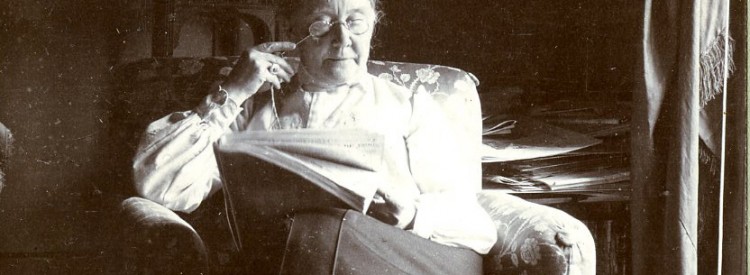More than 1,600 photographic images – cased photographs, cabinet cards, cartes de visites, glass plate negatives, lantern slides, mounted and un-mounted prints, passe-partouts, stereographs, and tin types – comprise the Hill-Stead photography collection.
Of note are 20 photographs taken by Gertrude Käsebier, including seven of her “art” photographs, nearly 400 photographs taken by Theodate Pope Riddle, and a small collection of 20 autochromes unfaded in color. Also included in the collection is a selection of photos by Karl Klauser.
Theodate Pope, Photographer
Theodate Pope Riddle (1867-1946) was an avid amateur photographer of family, friends, her extensive travels to Europe and a 1902 trip to Mexico.
As most of her photos were taken by a stereo camera, each of her portraits are actually twin images, virtually identical, but from minutely different angles. The camera used two lenses set approximately 2 ½ inches apart, with both exposures made simultaneously. The resulting paired images, when viewed through a stereoscope, created a three-dimensional view that imitated a person’s natural vision, in which each eye views a scene from a slightly different aspect.
In her diaries, Theodate mentions her camera purchases, including that of a “detective camera,” and alludes frequently to her photography practice. Her enthusiasm coincided with an era in which photography became technically and financially accessible to the general population, and the enterprising Theodate became part of a world-wide camera craze. Had she chosen to focus her attentions more fully on photography, her strong sense of aesthetics and creativity might have made her a respected photographic artist, as was her friend Gertrude Käsebier. Her, and her parents’, interest in photography as an art form is evidenced in the fact that Käsebier was hired to photograph Theodate and her parents, in “candid” poses in and about Hill-Stead. Additionally, Theodate contracted with local photographer Karl Klauser (1823-1905) to photograph her home at 13 High Street (the “O’Rourkery”) in Farmington.
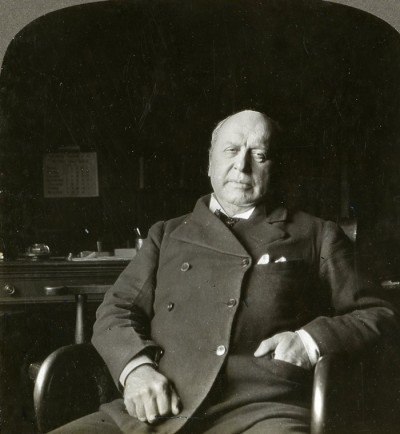 Portrait of Author Henry James
Portrait of Author Henry James
Stereograph image, 1910
3⅛ x 3⅛ in.
(HSM #208)
Theodate Pope’s pictures are mostly of family and close friends, some of them famous figures in literature and the arts. One of these friends was Henry James (1843-1916), a novelist much celebrated during Theodate’s lifetime. She met James during a trip abroad in 1910, and the two immediately became friends, exchanging letters and visiting one another over the course of several years. It is clear that James considered Theodate a close friend. He was supportive when Theodate’s father died, and stood by her after her traumatic experience aboard the ill-fated Lusitania. In Theodate’s stereo-photograph of James, he is shown seated in front of a desk and shelves of books, a scene that invokes the stature he had already achieved as a writer and thinker.
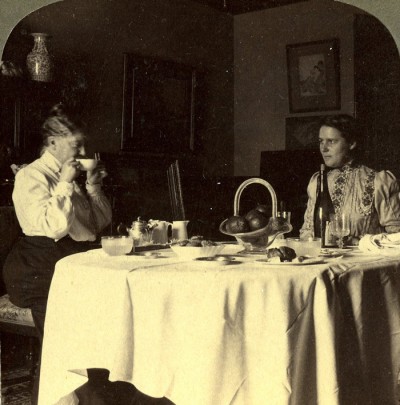 Portrait of Mary Hillard and Mary Cassatt
Portrait of Mary Hillard and Mary Cassatt
Stereograph image,1903-1905
3⅛ x 3⅛ in.
(HSM #290)
Theodate Pope took this stereophoto of her friends, educator Mary Hillard (1863-1932) and the painter Mary Cassatt, in Cassatt’s country home on the outskirts of Paris. Cassatt was from a wealthy American family, although she lived in France for most of her career as a painter. Theodate made several visits to Cassatt’s home. Mary Hillard joined Theodate on a 1903 visit and the three women discussed the girls’ school that Theodate was designing for Hillard, her former mentor from Miss Porter’s School in Farmington, Connecticut. Cassatt shared Theodate’s spiritualist views, and they often discussed the possibility of an afterlife in their written correspondence. After the death of Mary Hillard’s younger brother John, also a close friend of Theodate’s, Cassatt advised that Theodate and Mary Hillard visit the American Society for Psychical Research in Boston to attempt to contact John’s spirit. When Theodate’s father died, Mary Cassatt sent a letter expressing her sorrow, and the two maintained a close friendship until the artist’s death in 1926.
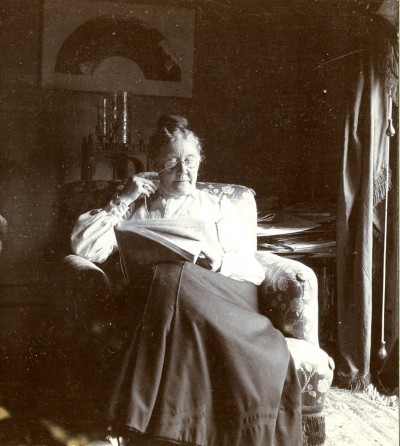 Portrait of Mary Cassatt
Portrait of Mary Cassatt
Stereograph image, 1903-1905
3⅛ x 3⅛ in.
(HSM #288)
This is another image of Mary Cassatt (1844-1926), taken by Theodate Pope during one of many visits to the artist’s home in Paris, France. In this intimate photograph, Cassatt poses in a chair beside the window, reading the newspaper. Seen in the background is a fan-shaped painting by her good friend, Edgar Degas.
In Hill-Stead’s archive is Mary Cassatt’s reply to Theodate Pope’s letter in which she asks permission to photograph her, postmarked April 21, 1903. “Dear Miss Pope, Certainly I will sit for you but I warn you the result will be terrible and you will loose a plate, still we will try …Yours, Mary Cassatt.”
Gertrude Käsebier (1852-1934)
Gertrude Käsebier was an artist and a professional photographer. In the 1890’s, while being formally trained in art at Brooklyn’s Pratt Institute, she became interested in the “new” medium of photography. During study abroad in France, she began to pursue photography in earnest as the field was also deemed acceptable for women. Unimpeded by her marriage and her three children, Käsebier was determined to become a professional photographer. Throughout her career she maintained a thriving portrait business in New York City, while exhibiting her more artistic, pictorial photography and winning numerous awards.
She was a colleague and friend to photographers Alfred Stieglitz and Edward Steichen and, like them, believed photography was the equal of other art forms. She was also a member of Stieglitz’s Photo-Secession group formed in 1902 and dedicated herself to the promotion of photography as a fine art. Her work was often included in Stieglitz’s Photo-Secession galleries at 291 Fifth Avenue and in his independent Camera Work magazine.
From her studio on New York City’s Fifth Avenue, she photographed such renowned figures as writers Mark Twain and Booker T. Washington, architect Stanford White and photographers Jacob Riis and Alfred Stieglitz. Her studio portraits of Mr. Pope capture both his discerning manner and his charm, while Theodate is portrayed at Hill-Stead as a sensitive yet confident intellectual.
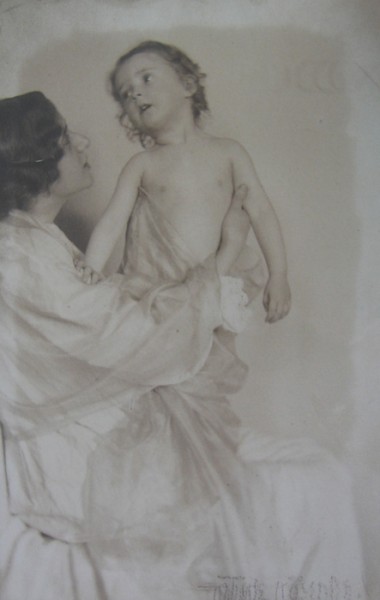 Mother and Child (alternately titled Adoration and The Vision)
Mother and Child (alternately titled Adoration and The Vision)
Brown platinum print, 1897
7 ⅝ x 6 in.
(HSM #121)
Today Käsebier is best known for her pictorial photographs of mothers and children, of which Adoration is a prime example. Adoration includes a simple, restrained composition that recalls Whistler’s famous portrait of his mother, Arrangement in Grey and Black No. 1 (1871). It is as much a study of subtle tonalities of white as it is a study of motherhood. The subject of mother and child found in Adoration was not a new interest for Alfred Pope. His art collection already contained two paintings by the French Symbolist artist Eugène Carrière and several by Mary Cassatt, all depicting images of mothers and children. Adoration therefore was a fitting complement to the paintings in his collection. An affinity with the traditional fine arts, seen in Adoration’s connection to Whistler, Carrière, and Cassatt and to historic images of the Madonna and child, can be seen in much of Käsebier’s work.
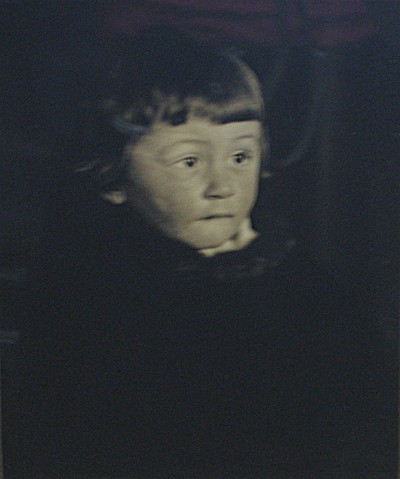 Portrait of a Boy
Portrait of a Boy
Platinum print, 1897
6 ⅛ x 4 ⅞ in.
(HSM #120)
Contrary to the attitudes of many of her contemporaries, Gertrude Käsebier believed photography was a valid medium for artistic expression. To reinforce the kinship between painting and photography, she strove to emulate the technique and look of “old master” painters. Käsebier would dress her subjects in Renaissance-inspired or “Titianesque” gowns and silhouette them against dark backgrounds. In this photograph, the boy is dressed in clothing that is stylistically similar to the dress of figures in portraits from the Renaissance. The dim background and the boy’s expression are also reminiscent of Renaissance portraiture, revealing Käsebier’s extensive art historical knowledge. Käsebier would often print her photographs on canvas-textured backgrounds, in an attempt to capture the characteristics of a painting.
Karl Klauser (1823-1905)
Karl Klauser was born in 1823, in St. Petersburg, Russia, to Swiss parents. He studied music in Leipzig and Hamburg before emigrating to the U.S. in 1850 and learning the craft of photography from his brother William, who had arrived in America two years earlier. In 1855, Klauser was recommended to Sarah Porter as a potential music director for her school, and moved to Farmington to serve at Miss Porter’s School for 28 years as a music teacher. Klauser continued to photograph in Farmington, and, upon retiring from teaching, he developed his skills into a new profession, selling his work to Miss Porter’s students, alumnae and visitors to the town. Klauser’s subjects ranged from Miss Porter’s School class portraits to Farmington landscapes and building interiors.
Passage adapted from an essay for the exhibition Imagining Farmington: The 19th-century photographs of Karl Klauser, Stanley-Whitman House, Farmington, CT, Summer-Fall 2006, by Barbara Donahue.
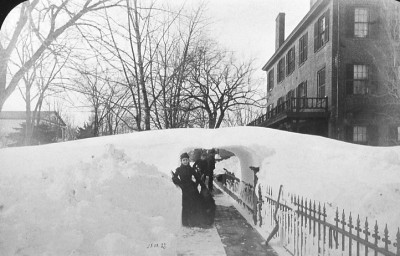 Snow Tunnel in Front of Miss Porter’s School
Snow Tunnel in Front of Miss Porter’s School
Photograph, 1888
4⅜ x 7 in.
(HSM #41)
Karl Klauser took this photograph outside of Miss Porter’s School during the Blizzard of 1888, the “storm of the century” in the eastern U.S. Three days of snow made travel impossible, and caused snowdrifts that reached heights of 40 feet. The photograph includes Klauser’s three main areas of photographic interest: Miss Porter’s students, the town of Farmington, and the natural landscape. The scene is carefully composed, with the sidewalk leading into the frame from one side, and the snow arching over the path to cause a break between the landscape and the isolated, ethereal world created by the snowstorm.
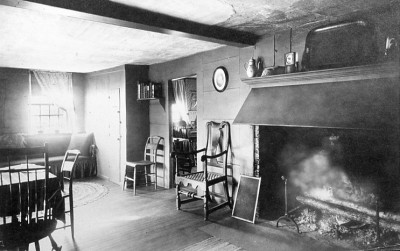 Keeping Room, “The O’Rourkery”
Keeping Room, “The O’Rourkery”
Photograph, c. 1900
4⅜ x 6¾ in.
(HSM #116)
This image was taken in the keeping room of Theodate Pope’s cottage, the “O’Rourkery,” on High Street in Farmington. After purchasing the brown saltbox in 1890, Theodate renovated and decorated it to resemble an old farmhouse, making it her home for many years before eventually moving into Hill-Stead. Karl Klauser’s portrayal of the keeping room reveals his sense of the importance of light in creating the mood of a photograph. A long exposure has created a soft glow from the window to the left, which is echoed in the window light coming from the next room, as well as the fire’s glow in the lower right corner of the image. Klauser has set up the composition so that the eye wanders diagonally from the bright window in the first room to the window in the second room, to the fireplace and back again in a visual loop. The patterns of the chairs and their shadows also contribute to the simple formal beauty of the image.
